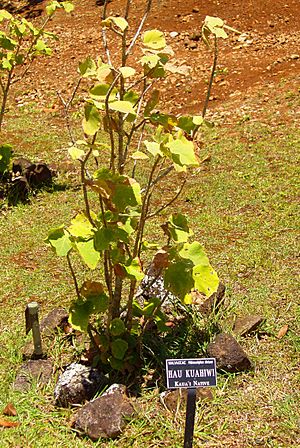Kauai hau kuahiwi facts for kids
Quick facts for kids Kauai hau kuahiwi |
|
|---|---|
 |
|
| Hibiscadelphus distans growing in Limahuli Garden and Preserve | |
| Conservation status | |
| Scientific classification | |
| Genus: |
Hibiscadelphus
|
| Species: |
distans
|
The Hibiscadelphus distans, also known as Kauai hau kuahiwi, is a super rare flowering plant. It belongs to the mallow family and is found only on the island of Kauaʻi in Hawaii. In Hawaiian, its name hau kuahiwi means "upland Hibiscus tiliaceus."
This plant is usually a bush or a small tree. It has cool heart-shaped leaves and bright yellow flowers. It grows in the remains of native dry forests, usually between 1,000 and 1,800 feet (300 and 550 meters) above sea level. Even though it's very rare, it's thought to be the only Hibiscadelphus species still alive in the wild. All five other species from Hawaii have sadly disappeared recently.
Contents
What Does It Look Like?
Hibiscadelphus distans can be a shrub or a small tree. It can grow up to about 16 feet (5 meters) tall. It has smooth bark and a round top.
Leaves and Flowers
Its leaves are shaped like hearts and are about 1.5 to 4 inches (4 to 10 cm) long. They have rounded edges with tiny bumps. Both the top and bottom of the leaves are covered in tiny star-shaped hairs, called stellate trichomes.
The flowers are about 1 to 1.5 inches (3 to 4 cm) long. They are surrounded by small, triangular leaf-like parts called bracts. The green parts at the base of the flower, called sepals, form a tube around the petals. The petals are greenish-yellow when they first bloom, but they turn a reddish-brown color as they get older.
Fruit and Seeds
After the flower, a fruit grows. It's a dry pod, about 1 inch (2.5 cm) long and 0.6 inches (1.5 cm) wide. This pod is split into five sections. Each section holds two small seeds, which are about 0.2 inches (5 mm) long. When the fruit is ready, it opens up to release the seeds. This process is called dehiscence.
Where Does It Live?
The Kauai hau kuahiwi grows in places that are not too high up, between 1,000 and 1,800 feet (300 and 550 meters). It lives in parts of native dry forests that have been changed a lot by humans. The ground where it grows is made of basalt rock with dry, crumbly reddish-brown soil on top.
Current Home
Today, most of these plants live in the Lower Koaiʻe Canyon. This area is a small valley that leads into Waimea Canyon. Here, the plants grow at about 1,150 feet (350 meters) above sea level. The temperature in this area usually ranges from 65 to 78 degrees Fahrenheit (18.5 to 25.7 degrees Celsius). It gets about 60 inches (150 cm) of rain each year.
Plant Neighbors
Other plants that grow near the Kauai hau kuahiwi include:
- Kukui (Aleurites moluccana)
- ʻĀhinahina (Artemisia kauaiensis)
- Alaheʻe (Psydrax odorata)
- Lama (Diospyros sandwicensis)
- Nehe (Lipochaeta connata)
- Kōlea (Myrsine species)
- Kuluʻī (Nototrichium sandwicense)
- ʻĀlaʻa (Pouteria sandwicensis)
- Sacramento Bur (Triumfetta semitriloba)
- Āulu (Sapindus oahuensis)
Saving This Rare Plant
There are only two groups of H. distans plants that grow naturally. Both are in the Lower Koaiʻe Canyon area, within the Puʻu Ka Pele Forest Reserve. Scientists believe there are about 20 wild trees and 150 trees that have been planted back into nature.
Past Challenges
The first group of these plants was found in 1972 in Koaiʻe Canyon. But in 1989, a landslide destroyed this group. Another group of fifty trees in the Hipalau Valley was lost in 1992 because of Hurricane Iniki.
Helping Hands
Luckily, two special gardens in Hawaii are helping to grow this plant. They are the McBryde Garden (part of the National Tropical Botanical Garden) on Kauaʻi and Waimea Valley on Oʻahu. They grow these plants to help make sure they don't disappear forever.
Even though H. distans is extremely rare, it actually has the largest wild population of any Hibiscadelphus species. Five of the other six species are either completely gone or only exist in gardens. Four of those species were only ever known from a single plant in the wild! The only other Hibiscadelphus species still found in the wild is H. woodii, also from Kauaʻi, which has only four known plants.


